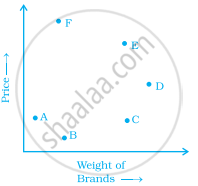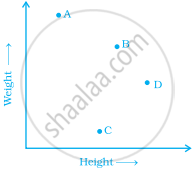Advertisements
Advertisements
प्रश्न
Match the ordinates of the points given in Column A with the items mentioned in Column B.
| Column A | Column B |
| (a) (7, 0) | (i) The ordinate is double the abscissa. |
| (b) (11, 11) | (ii) The ordinate is zero. |
| (c) (4, 8) | (iii) The ordinate is equal to the abscissa. |
| (d) (6, 2) | (iv) The abscissa is double the ordinate. |
| (e) (0, 9) | (v) The abscissa is triple the ordinate. |
| (f) (6, 3) | (vi) The abscissa is zero. |
उत्तर
| Column A | Column B |
| (a) (7, 0) | (ii) The ordinate is zero. |
| (b) (11, 11) | (iii) The ordinate is equal to the abscissa. |
| (c) (4, 8) | (i) The ordinate is double the abscissa. |
| (d) (6, 2) | (v) The abscissa is triple the ordinate. |
| (e) (0, 9) | (vi) The abscissa is zero. |
| (f) (6, 3) | (iv) The abscissa is double the ordinate. |
Explanation:
(a) Clearly, the ordinate of the point (7, 0) is zero.
(b) In the point (11, 11), the ordinate is equal to the abscissa.
(c) In the point (4, 8), the ordinate is double of the abscissa.
(d) In the point (6, 2), the abscissa, i.e. x-coordinate is triple of the ordinate, i.e. y-coordinate.
(e) The abscissa of the point (0, 9) is zero.
(f) Clearly, the abscissa is double of the ordinate.
APPEARS IN
संबंधित प्रश्न
Plot the points (5, 0), (5, 1), (5, 8). Do they lie on a line? What is your observation?
Locate the points:
(2, 1), (2, 2), (2, 3), (2, 4)
Decide which of the following statements is true and which is false. Give reasons for your answer.
The coordinates of the origin are (0, 0).
The following table shows the amount of rice grown by a farmer in different years:
| Years: | 2000 | 2001 | 2002 | 2003 | 2004 | 2005 | 2006 |
| Rice grown (in quintals): | 200 | 180 | 240 | 260 | 250 | 200 | 270 |
Plot a graph to illustrate this information.
In the given graph the letter that indicates the point (0, 3) is ______.

Write the y-coordinate (ordinate) of the given point.
(3, 5)
Write the y-coordinate (ordinate) of the given point.
(2, 7)
Draw a parallelogram ABCD on a graph paper with the coordinates given in Table I. Use this table to complete Tables II and III to get the coordinates of E, F, G, H and J, K, L, M.
| Point | (x, y) |
| A | (1, 1) |
| B | (4. 4) |
| C | (8, 4) |
| D | (5, 1) |
Table I
| Point | (0.5x, 0.5y) |
| E | (0.5, 0.5) |
| F | |
| G | |
| H |
Table II
| Point | (2x, 1.5y) |
| J | (2, 1.5) |
| K | |
| L | |
| M |
Table III
Draw parallelograms EFGH and JKLM on the same graph paper.
Plot the points (2, 4) and (4, 2) on a graph paper, then draw a line segment joining these two points.
The graph given below compares the price (in Rs) and weight of 6 bags (in kg) of sugar of different brands A, B, C, D, E, F.

- Which brand(s) costs/cost more than Brand D?
- Bag of which brand of sugar is the heaviest?
- Which brands weigh the same?
- Which brands are heavier than brand B?
- Which bag is the lightest?
- Which bags are of the same price?
The points on the graph below represent the height and weight of the donkey, dog, crocodile, and ostrich shown in the drawing.

- What are the two variables represented in the graph?
- Which point represents each animals? Explain.
